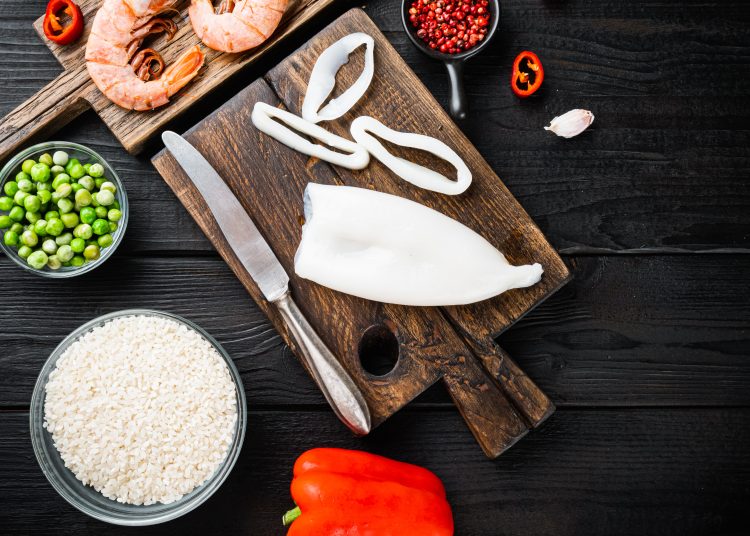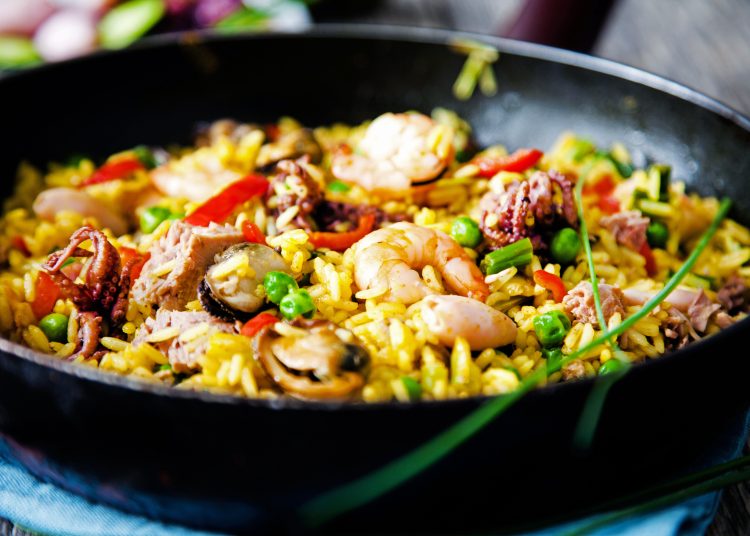Imagine sitting down to a vibrant, steaming pan of Paella, the aroma of saffron and garlic mingling in the air. This iconic Spanish dish is not just a feast for the palate but a colorful canvas of rice, vegetables, and protein, often cooked and served in the wide, shallow pan that gives it its name. Paella’s cultural significance is as rich as its flavors, deeply rooted in the traditions of Valencia, Spain, where it was born in the mid-19th century. With each bite, you’re enjoying a meal that has been bringing families and communities together for generations.
Recipe

Ingredients:
- 2 cups short-grain rice, like Arborio
- 4 cups chicken or vegetable broth
- 1 large onion, finely chopped
- 1 red bell pepper, sliced
- 4 cloves of garlic, minced
- 1 (14.5-ounce) can diced tomatoes, drained
- 1 tablespoon paprika
- 1/2 teaspoon saffron threads (optional)
- 1 1/2 pounds chicken thighs, bite-sized pieces
- 1 pound shrimp, peeled and deveined
- 1 cup frozen peas
- 2 tablespoons olive oil
- Salt and pepper to taste
- Lemon wedges and chopped parsley for garnish
Instructions:
- Heat olive oil in a large skillet or paella pan. Brown chicken with salt and pepper, set aside.
- Sauté onion and bell pepper until soft.
- Add garlic, cook until fragrant.
- Stir in rice, coat well. Cook for 2 minutes.
- Add paprika, saffron (or turmeric), and tomatoes. Cook 2 minutes.
- Pour in broth, simmer. Add chicken, cook 15 minutes without stirring.
- Add shrimp, cover and cook 10 minutes.
- Add peas, cover, cook 5 minutes.
- Check rice, cook more if needed.
- Let sit covered for 5 minutes, garnish with parsley and lemon.
Fun Facts about Paella


You might be surprised to learn that Paella wasn’t always the seafood dish many people think of today. Its beginnings trace back to Valencia’s fields, where workers cooked rice with whatever they had on hand, typically rabbit, chicken, and a few types of local beans. Over time, seafood found its way into the pan as Paella traveled from the countryside to the coast. This gave rise to the diverse variations we see now, including mixed Paella that combines meat and seafood for a fulfilling experience.
Paella has a communal spirit, often cooked in large quantities to be shared at festivals and family gatherings, especially on Sundays. It’s about togetherness that comes with sharing a meal straight from the pan. Eating Paella is just as important as how it is made, embodying a social experience of sharing and enjoying life.
Cost-wise, Paella can suit any budget. A traditional dish might cost €10-€20 per person in a local Spanish restaurant. However, prices can increase in high-end restaurants or outside of Spain, where it’s considered an exotic dish. Despite this, the essence of Paella stays the same: a hearty, rustic meal that brings people together.
Modern takes on Paella show the creativity of chefs who like to experiment. From vegan versions that highlight assorted vegetables to avant-garde dishes that innovate on traditional flavors, Paella continues to adapt. Yet, no matter what the variation, it remains a dish associated with celebration, family, and the simple joy of a meal enjoyed outdoors.

